Watery eyes and excess tearing is one of the most common complaints I get from my senior patients. It is not vision-threatening but it can be an ongoing frustration – constantly having to wipe away excess tears from around your eyes and down your cheeks. This condition is often chronic but can be worse when doing concentrated focussing tasks (reading or computer) or when exposed to cold and wind; for example, your eyes might tear up after reading for 20min, or soon after stepping outdoors in the winter.
This condition, called epiphora, is a difficult one to solve and can have many underlying causes. The most common causes in older people are reflex tearing and eyelid malposition.
Reflex tearing is a reaction to surface irritation on the eyeball, most often due to dry eyes. I do realize that it is counter-intuitive to say that overly watery eyes may be caused by dry eyes to begin with, but this really is the case! Using strategies to mitigate dry eyes and surface irritation (use of artificial tears, warm compresses, dietary omega 3 oil supplements) is often helpful to prevent excess watering of your eyes.
The other common cause of chronic watery eyes in seniors is due to eyelid laxity and malposition. As we get older, our eyelids get more lax and this can throw off the positioning of the small drainage ducts that collect our tears and drain them into our sinuses. The ducts may be open and functional, but they are not lined up properly to effectively catch the tears before they spill over our eyelids. Another related laxity issue results from the conjunctiva (the clear elastic membrane overlying the white part of the eyes) getting loose and wrinkled/heaped up against the eyelid margin, giving the tears an easy escape route over the eyelid margin and down your cheeks. Some lid malposition issues are severe and may require surgical intervention, but most are mild and do not require surgery.
If excess tearing is sudden-onset and constant in one eye, with no other symptoms of pain or redness, there could be a blockage of one of the drainage ducts. You should see an eye care professional for further assessment.
If excess tearing is sudden onset and associated with redness, pain or light sensitivity, this may be the result of an eye infection or acute inflammation and you should see your doctor of optometry right away for assessment and treatment.
Dr. Lisa Scharf


